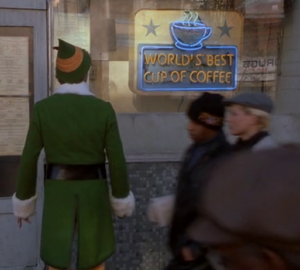When small-batch, artisanal food leapt enthusiastically into the gullet of indie culture, it was no surprise that the fancy coffee world–that lower-calorie, daily addiction with packaging just as cute!–would quickly follow. It’s similarly no surprise that the adorably curated, highly gift-savvy people at Mouth.com would turn to the coffee world for their next step in expanding their comprehensive indie food boutique.
Unlike some other online retailers offering coffee subscriptions and samplers, which are often drop-shipped from the roaster itself or repackaged in small quantity, Mouth warehouses coffee like all of its inventory, from a fridge full of cheese to all 85 unique pickle SKUS. Bundles of cute food are sent out into the world in, what else? Custom canvas tote bags. This is what founder Craig Kanarick calls “putting it together in an experience.” On more than one item on the Mouth shelves, we found unusual ingredients listed on the product packaging, such as “love” (currently unregulated by the FDA), or “made with 100% sweet, magic air.”
We paid a visit to Mouth’s Brooklyn, NY headquarters–a startup-minimal office in DUMBO comprised of warehousing space, a shipping area, and various desks strewn with charming jars of licorice–for a face-to-face chat with Mr. Kanarick about the young company’s newest venture into the coffee world.
Coffee’s been striving for acceptance alongside the culinary community for a long time. There are already a few online retailers selling a selection of artisan coffees, but no one’s paired them as thoughtfully with fine coffees as you have. How did you decide to expand into coffee?
We definitely wanted to have some coffee from the very beginning. We got into coffee because we knew the people who are passionate about pickles and cookies and granola are passionate about coffee, and were asking us when we were going to start carrying coffee.
But unlike, say, bacon jam, coffee already had a huge amount of purveyors who were quite good at the roasting craft. Your roster includes a range of creative national roasters like Kuma, Madcap, Ozo, Olympia Coffee Roasters and Coava. How did you begin your selection?
We had someone come in here and train us and taught us how to do cuppings, and we did a bunch of them here, we also continuously just made coffee all the time and tried to do it very consistently, so that we would eliminate the brewing method as a variable.
What we were really looking to do was find the roasters that we felt were the most representative of what we’re trying to represent in the indie food word, so people who were putting a high level of craft into what they were doing, who were running business that we thought were the right kind of businesses. And of course we tried to get a wide range of representation–we wanted to cover the entire range of aspects–the origins and the way they’re processed and the type of bean, but by the same token, all across the country. Nothing against Portland, but we wanted to make sure people knew that there are a lot of roasters acrosst he country that are working to elevate this “3rd Wave of Coffee” into a bigger movement.
Managing freshness and inventory has long been the bane of multi-roaster cafes, and even more problematically, in food stores. How are you facing this challenge?
Coffee is one of our products where the shelf life is a bit shorter than some of the other stuff. Peanut butter is good for a year, pickles are good for a year, honey’s good forever. We look at it per coffee. Sometimes it’s four weeks, sometimes it’s six weeks. And it depends on the how the coffee is packaged.
This is much more work, coffee, than jam. A lot of these products are seasonal. We’re having to go back and talk to these roasters fairly often and taste new versions of what they have. They’re not changing the recipe, this is this, and has a best buy date of a year from now. [Coffee has] a shorter shelf life, it’s a seasonal product…you may fall in love with Madcap La Princesa and we may not have it two months from now.
We’re really down to a day to day for the freshness, so it may be, in [a 24 hour period], we look at it and go, we should do something fresher, rather than go back and change the website. And the roasters are helping us in a lot of cases with making substitutions.
How do you decide which coffees go in each gift set? Are you pairing particular flavors?
In the gift bags, a lot of the time the coffees are the ones that we would say are not the furthest out there in terms of super acidic or super dark roast, super fruity. We’re trying to pick coffees that are a little more, I don’t want to say mainstream, but more in the middle–that would be more likely to be something liked by someone you’re giving a gift to. If you’re shopping for yourself you’re going to shop, you know what you like. But a lot of times you don’t know what Uncle Joey likes to drink…even if you’re getting some extreme flavors in there like bacon cinnamon rolls and ginger cookies.
Are there plans to have a package that highlights a more “out there” coffee?
As we gain traction, yes. For the coffee subscription, we’re curating each month around a theme, so if you have bought yourself a coffee subscription, you’re probably in the target where you’d be more adventurous.
Rather than putting let’s say, one out there coffee in every month, we’re trying to be a little more thematic. It also gives us an opportunity to do a little bit of teaching–educating–so that we can put something in where each month comes with a little guide to one aspect of coffee, whether it’s roasting level, what’s the effect of elevation, what’s the effect of different types of processing. This is the first time that we’ve done this, and we’ve only sent out one month of subscriptions so far–the first month was all washed coffees, it gave us a chance to talk about what does that mean, and may is blends.
And you’re writing these guides in-house?
We have a team. It’s a great way for us to experiement with this type of content, and we’re about to launch a liquor store online as well, so we’re going to be trying out a similar thing. I don’t think we’re going to send out a guide on the difference between jam, jelly, and marmalade anytime soon…though we do get asked that question.
Any plans to expand into brewing equipment?
A little bit. We’re primarily in the food business. We do have two pieces of equipment that we sell: the Kone coffee filter, and a Jonathan’s Wild Cherry wooden coffee scoop.
It’s an interesting challenge for us, because we’re trying to make sure that, first of all, everything we carry in the entire store is made in America. So that already eliminates a fair amount of equipment. But we understand that we’re going to be a place where people can get what they want, it’s a natural place for us to expland into. But for us, we’re so engaged with the maker community on the food side–and there’s still so much more to go! Right now I’ve got 180 olive oils i have to figure out!
You can check out Mouth.com’s brand new coffee program, either as purchases of individual bags, in gift sets, or in subscription form here (alongside comparable subscriptions like Cookies Every Night and Jerky Every Month).
Liz Clayton is the author of “Nice Coffee Time“, a regular columnist for Serious Eats: Drinks, and New York City bureau chief at Sprudge.com. She lives in Brooklyn. Read more Liz Clayton here.








































